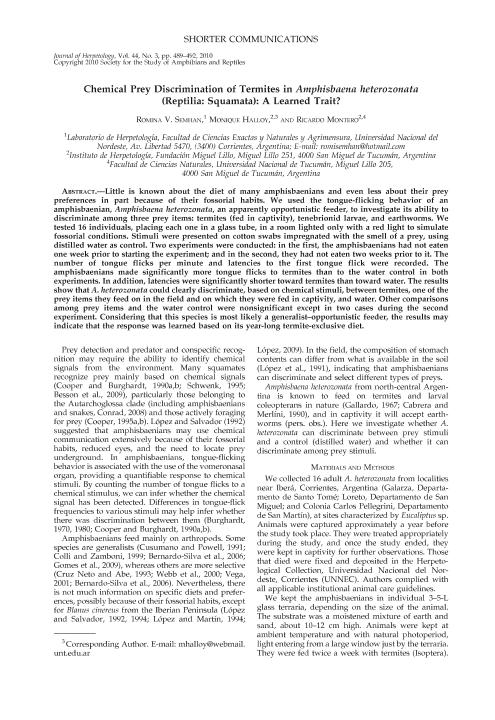Mostrar el registro sencillo del ítem
dc.contributor.author
Semhan, Romina Valeria

dc.contributor.author
Halloy, Monique

dc.contributor.author
Montero, Ricardo

dc.date.available
2019-04-10T20:51:34Z
dc.date.issued
2010-09
dc.identifier.citation
Semhan, Romina Valeria; Halloy, Monique; Montero, Ricardo; Chemical prey discrimination of termites in Amphisbaena heterozonata (Reptilia: Squamata): A learned trait?; Society for the Study of Amphibians and Reptiles; Journal of Herpetology; 44; 3; 9-2010; 489-492
dc.identifier.issn
0022-1511
dc.identifier.uri
http://hdl.handle.net/11336/74006
dc.description.abstract
Little is known about the diet of many amphisbaenians and even less about their prey preferences in part because of their fossorial habits. We used the tongue-flicking behavior of an amphisbaenian, Amphisbaena heterozonata, an apparently opportunistic feeder, to investigate its ability to discriminate among three prey items: termites (fed in captivity), tenebrionid larvae, and earthworms. We tested 16 individuals, placing each one in a glass tube, in a room lighted only with a red light to simulate fossorial conditions. Stimuli were presented on cotton swabs impregnated with the smell of a prey, using distilled water as control. Two experiments were conducted: in the first, the amphisbaenians had not eaten one week prior to starting the experiment; and in the second, they had not eaten two weeks prior to it. The number of tongue flicks per minute and latencies to the first tongue flick were recorded. The amphisbaenians made significantly more tongue flicks to termites than to the water control in both experiments. In addition, latencies were significantly shorter toward termites than toward water. The results show that A. heterozonata could clearly discriminate, based on chemical stimuli, between termites, one of the prey items they feed on in the field and on which they were fed in captivity, and water. Other comparisons among prey items and the water control were nonsignificant except in two cases during the second experiment. Considering that this species is most likely a generalist-opportunistic feeder, the results may indicate that the response was learned based on its year-long termite-exclusive diet.
dc.format
application/pdf
dc.language.iso
eng
dc.publisher
Society for the Study of Amphibians and Reptiles

dc.rights
info:eu-repo/semantics/openAccess
dc.rights.uri
https://creativecommons.org/licenses/by-nc-sa/2.5/ar/
dc.subject
Amphisbaena Heterozonata
dc.subject
Chemical Signals
dc.subject
Termites
dc.subject
Prey Discrimination
dc.subject.classification
Otras Ciencias Biológicas

dc.subject.classification
Ciencias Biológicas

dc.subject.classification
CIENCIAS NATURALES Y EXACTAS

dc.title
Chemical prey discrimination of termites in Amphisbaena heterozonata (Reptilia: Squamata): A learned trait?
dc.type
info:eu-repo/semantics/article
dc.type
info:ar-repo/semantics/artículo
dc.type
info:eu-repo/semantics/publishedVersion
dc.date.updated
2019-04-05T16:12:05Z
dc.journal.volume
44
dc.journal.number
3
dc.journal.pagination
489-492
dc.journal.pais
Estados Unidos

dc.journal.ciudad
Salt Lake City
dc.description.fil
Fil: Semhan, Romina Valeria. Consejo Nacional de Investigaciones Científicas y Técnicas. Centro Científico Tecnológico Conicet - Tucumán; Argentina. Universidad Nacional del Nordeste. Facultad de Ciencias Exactas, Naturales y Agrimensura. Departamento de Biología. Laboratorio de Herpetología; Argentina
dc.description.fil
Fil: Halloy, Monique. Consejo Nacional de Investigaciones Científicas y Técnicas. Centro Científico Tecnológico Conicet - Tucumán; Argentina. Fundación Miguel Lillo. Dirección de Zoología. Instituto de Herpetología; Argentina
dc.description.fil
Fil: Montero, Ricardo. Consejo Nacional de Investigaciones Científicas y Técnicas. Centro Científico Tecnológico Conicet - Tucumán; Argentina. Fundación Miguel Lillo. Dirección de Zoología. Instituto de Herpetología; Argentina
dc.journal.title
Journal of Herpetology

dc.relation.alternativeid
info:eu-repo/semantics/altIdentifier/doi/https://doi.org/10.1670/09-062.1
dc.relation.alternativeid
info:eu-repo/semantics/altIdentifier/url/https://bioone.org/journals/Journal-of-Herpetology/volume-44/issue-3/09-062.1/Chemical-Prey-Discrimination-of-Termites-in-span-classgenus-speciesAmphisbaena-heterozonata/10.1670/09-062.1.short
Archivos asociados
